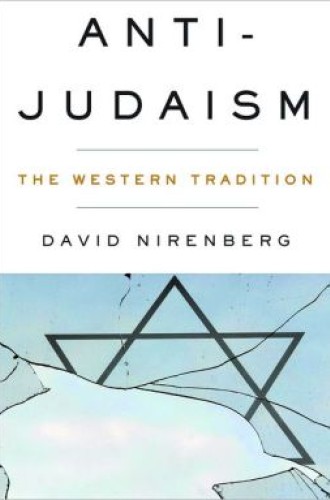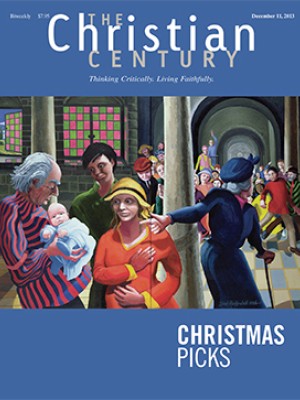Anti-Judaism, by David Nirenberg
In the 1960s, Jewish comedian Lenny Bruce famously quipped:
If you’re from New York and you’re Catholic, you’re still Jewish. If you’re from Butte, Montana, and you’re Jewish, you’re still goyish [non-Jewish]. . . . Italians are all Jews. Irishmen who have rejected their religion are Jews. Mouths are very Jewish. And bosoms.
In a benign and humorous way, Bruce’s sweeping stereotypes hint at a more often malevolent trend in millennia of Western thought. He slyly riffs on the ubiquitous deployment of vague notions of Jewishness to caricature groups with little or no connection to the practices or beliefs of living Jews.
Read our latest issue or browse back issues.
David Nirenberg, a medieval historian at the University of Chicago, has produced a highly learned intellectual history of anti-Judaism from ancient Egypt through the middle of the 20th century. Despite its weighty subject, the book is lively, engaging and accessible. It is analytically rigorous, though it sometimes tends toward the esoteric and obscure.
Nirenberg presents a chronological study of thinkers more than of events such as pogroms, discriminatory laws and expulsions, though he does cite events to illustrate some of the implications of anti-Judaism. Nirenberg’s focus is on the plasticity of the label “Jewish” and of the accusation of “Judaizing” in mostly religious and philosophical writings. Non-Jewish thinkers used these with stunning frequency to denounce both Jews and non-Jews—mostly the bitter enemies of whoever was deploying the label.
The book begins with a conventional survey of anti-Jewish tropes in pre-Christian Egypt, though these specific associations of Jews with misanthropy and lawlessness had limited influence. Nirenberg then shifts to the first few Christian centuries, when some of the most prominent and lasting usages of the terms Jewish and Judaizing emerged. Early Christians’ hostility was expressed in allegations that Jews were hypocritical or dangerous, overly legalistic and excessively focused on flesh over spirit, and these soon became ontological tropes applied to Jews and Judaism generally. The often inter-Jewish polemical circumstances of some New Testament texts were already entirely ignored in the second century. In a shockingly wide range of contexts, Christians such as Justin, Marcion, Augustine and Jerome, along with early Muslims, accused not only Jews but their own coreligionists of manifesting these negative, supposedly Jewish traits.
Nirenberg shows that anti-Judaism was a vague and adaptable trope. Thinkers tarred Jews as a dangerous other, though real Jews were seldom involved when these accusations were made or even present in the societies where this trope held sway. He also catalogues generic denunciations of Judaism as a (or the) worldview or theology in competition with the denouncer’s own.
Sharp dualisms help to explain the sense of paranoia and threat that suffused many statements about Judaism. For example, early Christian heresiologist Hegesippus said the diverse heresies that threatened orthodoxy all had their roots in Judaism. When the fourth-century bishop Ambrose of Milan was engaged in an inter-Christian dispute with the emperor over church and state, he insisted that Christian political and religious sovereignty would be threatened if Jews were not strenuously repressed. Among the most visible ways for medieval French and Spanish monarchs to demonstrate their piety was to denounce and expel the Jews. In the modern period, anti-Judaism was perpetuated and even strengthened despite growing hostility to religious claims. Voltaire, Kant, Marx, Hegel and many other luminaries continued to contrast “Jewish” materialism, obstinacy and legalism with whatever new perspectives they were developing.
Although some of Nirenberg’s close readings depend on existing scholarship and add little to what is already known, the cumulative effect of such a broad survey of largely Christian ancient, medieval and modern writers is powerful and sometimes shocking. Whether orthodox or heretical, Protestant or Catholic, believers or skeptics, church fathers or atheist philosophers (or dramatists, such as Shakespeare), many writers drew on widespread fantastical conceptions of Jewishness in the midst of intrareligious and intraphilosophical disputes. Despite deep disagreements about God, law, reason and progress, religious and antireligious thinkers alike were influenced by “a history that had encoded the threat of Judaism into some of the basic concepts of Western thought.” And anti-Judaism was not an insignificant feature of their thought: Nirenberg demonstrates that these thinkers often used opposition to Jews and Judaism to buttress their central arguments.
This claim, however, sometimes seems subjective. Nirenberg naturally focuses on the texts most suitable for his argument, and it is difficult to demonstrate just how central they are to each thinker’s overall oeuvre. He also includes marginal and idiosyncratic figures, inserting brief and sometimes puzzling short quotations without enough context or explanation.
On the other hand, he omits some prominent thinkers and contexts. For example, he limits his study to the “Western tradition,” omitting both Christian writers from the Eastern churches and most of Islam after Muhammad. Though he reasonably admits he lacks the linguistic skills to engage all of the relevant texts, the absence of a discussion of the modern Muslim world and the state of Israel in particular is unfortunate, especially because he does read Arabic. Although this might have made a long book even longer, it is disappointing that he does not consider the relevance of earlier anti-Jewish tropes to modern discussions of Israel by Muslims and Christians.
Though Nirenberg is generally an astute interpreter of texts, he sometimes draws sweeping conclusions from weak evidence. Qur’anic verses he cites as hostile to Jews refer to “the people of the book,” who include Christians as well as Jews. Similarly, his repeated references to computerized word studies of medieval Christian texts that show frequent usage of terms like Israel, Hebrew, Jew, Moses, Jerusalem or Zion do not necessarily indicate widespread interest in postbiblical Judaism or Jews. In a Christian context, these terms naturally would emerge in writings on the Bible.
Nirenberg’s notion of anti-Judaism is capacious, at times overly so. His sources’ perspectives range from bitter antagonism toward Jews and hateful accusations of Judaizing to neutral and even positive views. Those with more positive views seem like exceptions in a study largely devoted to those with hostile views. For example, Heinrich Heine deployed familiar dualisms of Jew and non-Jew, but his attitude toward Judaism was more favorable than that of many others in the book. Also, Nirenberg’s abrupt shift from the benign Heine to the murderous Nazi Joseph Goebbels illustrates a weakness of his encyclopedic approach of including almost any relevant thinker or statement, however diverse or discordant the thinkers’ views.
There are other differences between the thinkers that deserve more attention. Some moved beyond strictly theoretical and philosophical reflection and considered practical policies toward actual Jews. Marx and Heine seem to have had contemporary Jews in mind, though revolutionary-era French philosophers and Arthur Schopenhauer, for example, did not. Nirenberg, briefly notes these differences but sometimes treats them as an afterthought; he highlights shared themes while minimizing important differences.
The specific content of the accusations Nirenberg details is less important to his overall project than his convincing demonstration of the ubiquity and plasticity of anti-Judaism over so many centuries. Nirenberg deserves high praise for assiduously gathering and thoughtfully analyzing so many complex and often unsettling sources in one volume.







